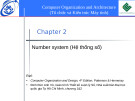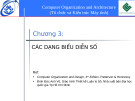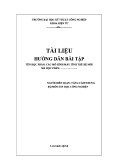Kiến trúc máy tính
Số học máy tính
NGUYỄN Ngọc Hoá
Bộ môn Hệ thống thông tin, Khoa CNTT
Đại học Quốc gia Hà Nội
Trường Đại học Công nghệ,
28 October 2015
Hoa.Nguyen@vnu.edu.vn
Nội dung
Tổng quan về CPU
Biểu diễn thông tin số Khái niệm thông tin số Biểu diễn ký tự Biểu diễn số nguyên Biểu diễn số thực
Logic số
Mạch kết hợp Bộ số học và logic Mạch tuần tự
Computer Architecture – Department of Information Systems @ NGUYỄN Ngọc Hoá Computer Architecture –Department of Information Systems @ Hoá NGUYEN
2 2
Kiến trúc tổng quan
Computer Architecture – Department of Information Systems @ NGUYỄN Ngọc Hoá Computer Architecture –Department of Information Systems @ Hoá NGUYEN
3 3
Chức năng máy tính
Thực thi chương trình, đã được xây dựng thông qua tập các
lệnh của CPU, lưu trong bộ nhớ
Các bước chính khi thực thi chương trình trong CPU
Tải lệnh từ bộ nhớ (fetch) Thực thi lệnh (execute) Lưu kết quả (store)
Computer Architecture – Department of Information Systems @ NGUYỄN Ngọc Hoá Computer Architecture –Department of Information Systems @ Hoá NGUYEN
4 4
Khái niệm thông tin
Thông tin số: tri thức về một trạng thái trong số một số hữu
hạn các trạng thái có thể có
Lượng tử thông tin:
1 bit là đại lượng thông tin gắn với tri thức của một trạng thái trong số
1 bit thông tin : được biểu diễn bởi số nhị phân 0,1 N bits 2n trạng thái khác nhau
Lượng thông tin chứa trong tri thức của một trạng thái trong số N là I
hai.
Độ lớn thông tin mà máy tính có thể thao tác: 8, 16, 32, 64 bits
Computer Architecture – Department of Information Systems @ NGUYỄN Ngọc Hoá Computer Architecture –Department of Information Systems @ Hoá NGUYEN
5 5
= log2N
Mã hoá
Tập các thông tin Bộ ký tự
I = {i1, . . . ,im} A = {a1, . . . ,an} ai : ký tự của A a1a3a4a8 : từ của A |A| : cơ số mã hoá
Mã hoá I : gán mỗi phần tử của I với một từ của A
Computer Architecture – Department of Information Systems @ NGUYỄN Ngọc Hoá Computer Architecture –Department of Information Systems @ Hoá NGUYEN
6 6
Đặc điểm
Dư thừa: 1 phần tử được gán với nhiều từ (mã)
Dư thừa: Số điện thoại cố định Không dư thừa: Số chứng minh thư
Độ dài:
Thay đổi: tín hiệu morse Cố định: số điện thoại di động
Với bộ mã độ dài cố định n, cơ số mã hoá b:
Có thể biểu diễn được bn phần tử và Có bn! cách mã hoá khác nhau
Computer Architecture – Department of Information Systems @ NGUYỄN Ngọc Hoá Computer Architecture –Department of Information Systems @ Hoá NGUYEN
7 7
Một vài bộ mã
Biểu diễn số:
Cần phân biệt số và cách thể hiện số. Thể hiện một số là một cách mã hoá Với cơ số b, ta có
Mã nhị phân: A = {0,1}
VD: 7 = (111)2
Mã hexa: A = {0,1,2,3,4,5,6,7,8,9,A,B,C,D,E,F} Mã DCB (Decimal Coded Binary): Mỗi chữ số được mã hoá nhị phân
10 : 0001 0000 25 : 0010 0101 …
Computer Architecture – Department of Information Systems @ NGUYỄN Ngọc Hoá Computer Architecture –Department of Information Systems @ Hoá NGUYEN
8 8
bằng 4 bits: 0 : 0000 1 : 0001 2 : 0010 …
Chuyển cơ số
Từ cơ số b về 10
anan−1…a1a0 với cơ số b (ký hiệu anan−1…a1a0b) : an × bn + an−1 × bn−1 + . . . + a1 × b + a0
Phần phân:
Từ cơ số 10 về cơ số b
A là số nguyên: A10 = an × bn + an−1 × bn−1 + . . . + a1 × b + a0
a1 × b−1 + a2 × b−2 + . . . + an × b−n
= ((. . . (an × b + an−1) × b + . . .) × b + a1) × b + a0
với a0 là phần dư của phép chia của A với cơ số b A là phần phân A10 = a1 × b−1 + a2 × b−2 + . . . + an × b−n
= (a1 + (a2 + (. . . + (an−1 + an × b−1)b−1 . . .)b−1)b−1)b−1
Computer Architecture – Department of Information Systems @ NGUYỄN Ngọc Hoá Computer Architecture –Department of Information Systems @ Hoá NGUYEN
9 9
với a1 là phần nguyên của phép nhân A với b
Nguyên lý chuyển
Phần nguyên:
Chia liên tiếp với cơ số Sử dụng phần dư
2510 /2 = 1210 dư 1 1210/2 = 610 dư 0 610/2 = 310 dư 0 310/2 = 110 dư 1 110/2 = 010 dư 1 Vậy 2510 = 110012
Phần phân:
Nhân liên tiếp với cơ số Sử dụng phần nguyên
0,7812510×2 = 1,562510 phần nguyên 1 0,562510 × 2 = 1,12510 phần nguyên 1 0,12510 × 2 = 0,2510 phần nguyên 0 0,2510 × 2 = 0,510 phần nguyên 0 0,510 × 2 = 110 phần nguyên 1 Vậy 0,7812510 = 0,110012
Computer Architecture – Department of Information Systems @ NGUYỄN Ngọc Hoá Computer Architecture –Department of Information Systems @ Hoá NGUYEN
10 10
Biểu diễn ký tự
ASCII (American Standard Code for Information Interchange) : sử dụng 1 byte đễ mã hoá ký tự AINSI: 7 bits A: 41H 9: 39H
ISO-8859: 8 bits để biểu diễn những ký tự có dấu (Ê : CAH)
Unicode:
Biểu diễn 1 ký tự thông qua 2 bytes Được sử dụng để biểu diễn những ký tự không phải latin ~ UCS (ISO 10646)
Computer Architecture – Department of Information Systems @ NGUYỄN Ngọc Hoá Computer Architecture –Department of Information Systems @ Hoá NGUYEN
11 11
Biểu diễn số nguyên
Số tự nhiên: sử dụng cơ số 2 để biểu diễn
Với n bits, ta có thể biểu diễn được những số tự nhiên N trong
Số nguyên:
Computer Architecture – Department of Information Systems @ NGUYỄN Ngọc Hoá Computer Architecture –Department of Information Systems @ Hoá NGUYEN
12 12
khoảng [0, 2n-1]
Biểu diễn số nguyên
Dấu và giá trị tuyệt đối : với n bits Dấu: bit phải nhất (0 : dương, 1 : âm) Giá trị tuyệt đối: n − 1 bits Khoảng giá trị biểu diễn: [−2n−1 + 1, 2n−1 − 1]
Bù 1: với n bits
Đảo bit của giá trị tuyệt đối |x| + (−|x|) = 2n − 1 Khoảng giá trị biểu diễn: [−2n−1 + 1,2n−1 − 1]
Bù 2: với n bits
Bù 1 + 1 |x| + (−|x|) = 2n Khoảng giá trị biểu diễn: [−2n−1,2n−1 − 1]
Computer Architecture – Department of Information Systems @ NGUYỄN Ngọc Hoá Computer Architecture –Department of Information Systems @ Hoá NGUYEN
13 13
Với 3 bits: [-3,3] 0 000 1 001 010 2 Với 3 bits: [-3,3] 3 011 0 000 -0 100 1 001 -1 101 Với 3 bits: [-4,3] 2 010 -2 110 0 000 3 011 -3 111 1 001 -3 100 2 010 -2 101 3 011 -1 110 -4 100 -0 111 -3 101 -2 110 -1 111
Biểu diễn số nguyên
Dư: với n bits
Thêm giá trị dư
Thường dư được lấy = 2n−1, và −|x| =
Khoảng giá trị biểu diễn: [−2n−1,2n−1 − 1]
x < 0 có thể biểu diễn được nếu x giá
2n−1 − |x|
trị dư
Computer Architecture – Department of Information Systems @ NGUYỄN Ngọc Hoá Computer Architecture –Department of Information Systems @ Hoá NGUYEN
14 14
Với 3 bits, dư 22=4: [-4,3] 000 001 010 011 100 101 110 111 -4 -3 -2 -1 0 1 2 3
Biểu diễn số thực
Một số thức ±m × be được biểu diễn bởi:
Dấu ±
Phần định trị m
Phần mũ e
Cơ sở b
có vô số cách biểu diễn có thể có với một số thực
Chuẩn hoá: chỉ dùng một chữ số khác 0 trước dấu phẩy
Khó khăn:
Giới hạn số chữ số mà máy tính có thể xử lý được làm tròn
Tiêu chuẩn chính xác (cách làm tròn), xử lý số quá lớn/quá nhỏ
VD: IEEE 754 xuất hiện 1977 nhưng đến 1985 mới được công nhận
Computer Architecture – Department of Information Systems @ NGUYỄN Ngọc Hoá Computer Architecture –Department of Information Systems @ Hoá NGUYEN
15 15
Chuẩn IEEE754
Chuẩn đơn:
1 8 23
e = E10 – 127 e [-127, 128]
Chuẩn kép:
s E (mũ) f (định trị)
s
E (mũ)
f (định trị)
e = E10 – 1023 e [-1023, 1024] Giá trị biểu diễn
1 11 52
f Giá trị
Chuẩn f (-1)s 1,f 2e
Không chuẩn 0
Zero 0
Vô cùng 0 (-1)s 0,f 2e (-1)s 0 (-1)s
http://en.wikipedia.org/wiki/IEEE_floating-point_standard
Computer Architecture – Department of Information Systems @ NGUYỄN Ngọc Hoá Computer Architecture –Department of Information Systems @ Hoá NGUYEN
16 16
NaN NaN 0 e emin< e < emax e = emin e = emin e = emax e = emax
Đại số Boole
Đề xuất bởi Georges Boole (1815-1864) với :
Một tập E Hai phần tử đặc biệt của E : 0 và 1 Hai phép toán nhị nguyên trên E : + và . Một phép toán đơn nguyên trên E : -
Tiên đề : cho a,b E
Giao hoán: Kết hợp: Phân phối: Phần tử trung hoà: a+0 = a
Bù:
a+ ā = 1
a+b = b+a (a+b)+c = a+(b+c) a(b+c) = ab+ac
Computer Architecture – Department of Information Systems @ NGUYỄN Ngọc Hoá Computer Architecture –Department of Information Systems @ Hoá NGUYEN
17 17
ab = ba (ab)c = a(bc) a+(bc) = (a+b)(a+c) a1 = a aā = 0
Đại số Boole
Định lý:
aa = a a0 = 0 a(a+b) = a ab = a + b
a+a = a Dư thừa: Phần tử hấp thụ: a+1 = 1 Hấp thụ: De Morgan: Chứng minh:
aa = aa + 0 = aa + aā = a(a + ā) = a1 = a a+a = (a+a)(a+a) = (aa+aa)+(aa+aa) = aa + aa a+a = a a + 1 = a + a + ā = a + ā = 1 a0 = aaā = aā = 0 a+ab = a(1+b) = a1 = 1 a(a+b) = aa + ab = a + ab = a
Computer Architecture – Department of Information Systems @ NGUYỄN Ngọc Hoá Computer Architecture –Department of Information Systems @ Hoá NGUYEN
18 18
a+ab = a a + b = a.b
Đại số Boole tối thiểu
E = {0,1} và ta có:
1 : “đúng” 0 : “sai” + : “hoặc” (hợp) . : “và” (giao) − : “Not” (phủ định)
Bảng chân lý: miêu tả một phép toán logic
a b a+b a ā a b ab a b ab
0
1
1
0 1
1 0
0 0 0
1 0 1
Computer Architecture – Department of Information Systems @ NGUYỄN Ngọc Hoá Computer Architecture –Department of Information Systems @ Hoá NGUYEN
19 19
0 0 1 1 0 1 0 1 0 0 0 1 0 0 1 1 0 1 0 1 0 1 1 0 1 1 1
Hàm boolean
Hàm nhị phân của các biến nhị phân : {0,1}n {0,1}
Thể hiện:
Bảng chân lý Biểu thức boolean
Chuyển từ bảng chân lý sang biểu thức logic Tổng nhân:
0 0 0 0 1 1 1 1
0 0 1 1 0 0 1 1
0 1 0 1 0 1 0 1
0 0 0 1 0 1 1 0
Nhân tổng:
Computer Architecture – Department of Information Systems @ NGUYỄN Ngọc Hoá Computer Architecture –Department of Information Systems @ Hoá NGUYEN
20 20
a b c F(a,b,c)
Đơn giản hóa biểu thức boolean
Sử dụng các tiên đề và định lý trong đại số Bool
Ví dụ :
Yếu điểm: Khó có thể khẳng định biểu thức cuối cùng là tối ưu nhất
Sử dụng bảng Karnaugh:
Computer Architecture – Department of Information Systems @ NGUYỄN Ngọc Hoá Computer Architecture –Department of Information Systems @ Hoá NGUYEN
21 21
hay chưa
Mạch logic
Những phép toán trong đại số Boole được thực hiện thông qua các mạch logics cơ bản, được gọi là các cổng logics
Cổng logics cơ bản
NOT
AND
OR
NAND
NOR
Computer Architecture – Department of Information Systems @ NGUYỄN Ngọc Hoá Computer Architecture –Department of Information Systems @ Hoá NGUYEN
22 22
XOR
Transistor Gates
AND
OR
NAND
NOR
NOR
Computer Architecture – Department of Information Systems @ NGUYỄN Ngọc Hoá Computer Architecture –Department of Information Systems @ Hoá NGUYEN
23 23
Mạch logic
Cổng 3 trạng thái
C
Y
A
1 0 0
1 1
0
Y Treo
C
Computer Architecture – Department of Information Systems @ NGUYỄN Ngọc Hoá Computer Architecture –Department of Information Systems @ Hoá NGUYEN
24 24
1 A X
Mạch logic
NAND và NOR
Đầy đủ: cho phép xây dựng được bất kỳ hàm boolean Dễ sản xuất Là thành phần cơ bản của hầu hết các mạch in trong các máy tính
Biểu thức boolean:
Có thể được thực hiện thông qua các cổng logic cơ bản Ví dụ:
Computer Architecture – Department of Information Systems @ NGUYỄN Ngọc Hoá Computer Architecture –Department of Information Systems @ Hoá NGUYEN
25 25
hiện nay
Mạch logic tổ hợp
Mạch có đầu ra biểu diễn biểu thức logic của các biến đầu
vào
Bộ giải mã :
cho phép gửi tín hiệu đến một đường ra chọn trước n đường vào, 2n đường ra
Computer Architecture – Department of Information Systems @ NGUYỄN Ngọc Hoá Computer Architecture –Department of Information Systems @ Hoá NGUYEN
26 26
Mạch logic tổ hợp…
Ví dụ: bộ giải mã n=2
Computer Architecture – Department of Information Systems @ NGUYỄN Ngọc Hoá Computer Architecture –Department of Information Systems @ Hoá NGUYEN
27 27
Mạch logic tổ hợp…
Bộ dồn kênh: chọn một từ nhiều đầu vào
2n đầu vào n đường chọn 1 đầu ra
Computer Architecture – Department of Information Systems @ NGUYỄN Ngọc Hoá Computer Architecture –Department of Information Systems @ Hoá NGUYEN
28 28
Mạch logic tổ hợp...
VD: n=2
Computer Architecture – Department of Information Systems @ NGUYỄN Ngọc Hoá Computer Architecture –Department of Information Systems @ Hoá NGUYEN
29 29
ALU (Arithmetic & Logic Unit)
Bộ bán cộng 1-bit:
0
0
0
0
x y S R
S = x y R = xy
0 1 1 0
1
1
0
1
1 0 1 0
x y S
Bộ cộng 1-bit đầy đủ:
Rout 0 0 Rin 0 0 0
1
0
0
0 0 1 1 0
1
0
S = x y Rin Rout = xy + Rin(x + y)
1 0 1 0 1
0 1 0 1 0
0 1 1 0 1
1 1 0 0 1
Computer Architecture – Department of Information Systems @ NGUYỄN Ngọc Hoá Computer Architecture –Department of Information Systems @ Hoá NGUYEN
30 30
1 1 1 1 1
ALU…
Bộ cộng 1-bit đầy đủ
Computer Architecture – Department of Information Systems @ NGUYỄN Ngọc Hoá Computer Architecture –Department of Information Systems @ Hoá NGUYEN
31 31
ALU…
Bộ cộng n-bits: ghép nối n bộ cộng đầy đủ 1-bit
Computer Architecture – Department of Information Systems @ NGUYỄN Ngọc Hoá Computer Architecture –Department of Information Systems @ Hoá NGUYEN
32 32
ALU…
Bộ trừ n-bits: sử dụng bộ cộng n-bits
x – y = x + ỹ + 1
C= 0: Cộng
C=1: Trừ
Computer Architecture – Department of Information Systems @ NGUYỄN Ngọc Hoá Computer Architecture –Department of Information Systems @ Hoá NGUYEN
33 33
ALU…
ALU: 3 phần tử cơ bản: ADD, AND và NOT ALU 1-bit:
Lựa chọn 1 đầu ra cho ALU 1-bit
Computer Architecture – Department of Information Systems @ NGUYỄN Ngọc Hoá Computer Architecture –Department of Information Systems @ Hoá NGUYEN
34 34
ALU…
ALU n-bits: kết hợp n ALU 1-bit
Computer Architecture – Department of Information Systems @ NGUYỄN Ngọc Hoá Computer Architecture –Department of Information Systems @ Hoá NGUYEN
35 35
Mạch tuần tự
Mạch kết hợp:
Không thể hiện được khái niệm thời gian Không thể hiện được khái niệm nhớ Mạch tuần tự: đầu ra phụ thuộc
Trạng thái của các biến vào Trạng thái trước đó của một vài đầu ra
Mạch tuần tự bao gồm:
Đầu vào I Đầu ra O Trạng thái trong S
và được định nghĩa bởi hàm O = f(I,S) xác định đầu ra mới S’ = g(I,S) chỉ trạng thái mới
Computer Architecture – Department of Information Systems @ NGUYỄN Ngọc Hoá Computer Architecture –Department of Information Systems @ Hoá NGUYEN
36 36
Ràng buộc về thời gian
Cần phải ước lượng thời gian chuyển đổi qua mỗi thành
phần và cấm truyền kết quả cho thành phần kế tiếp khi tính toán chưa xong rào chắn = xung đồng hồ
Computer Architecture – Department of Information Systems @ NGUYỄN Ngọc Hoá Computer Architecture –Department of Information Systems @ Hoá NGUYEN
37 37
Ràng buộc về thời gian…
Tác vụ một thành phần phải được hoàn thành trong một chu
kỳ
Clock
Computer Architecture – Department of Information Systems @ NGUYỄN Ngọc Hoá Computer Architecture –Department of Information Systems @ Hoá NGUYEN
38 38
Khái niệm nhớ
Tác vụ một thành phần có thể kéo dài tối đa 1 cycle => phải
lưu lại giá trị đầu vào trong 1 cycle
Đầu ra của 1 thành phần là đầu vào của thành phần kế tiếp
=> cần phải lưu lại giá trị đầu ra
Khi xung clock c=1: mở rào chắn(barrier), cho qua đầu ra Z
thông tin hiện có ở đầu vào X
Khi c=0: đóng rào chắn, cung cấp đầu ra thông tin trước đó
Computer Architecture – Department of Information Systems @ NGUYỄN Ngọc Hoá Computer Architecture –Department of Information Systems @ Hoá NGUYEN
39 39
Mạch tuần tự : Mạch lật
Latch SR: 2 tín hiệu điều khiển S (Set) và R (Reset)
R S
0 0 Qi x Qi+1 x
1
0
x
0
0 1 x 1
Computer Architecture – Department of Information Systems @ NGUYỄN Ngọc Hoá Computer Architecture –Department of Information Systems @ Hoá NGUYEN
40 40
1 1 x Cấm
Mạch lật theo xung đồng hồ
Computer Architecture – Department of Information Systems @ NGUYỄN Ngọc Hoá Computer Architecture –Department of Information Systems @ Hoá NGUYEN
41 41
Mạch lật…
Latch D: Sử dụng 1 tín hiệu điều khiển D (delay)
D Q
0 =D=0
Latch D hoạt động theo xung nhịp đồng hồ
1 =D=1
0
0
0 1
C D SR
1
0
0 1
0 1 1 0
Qi+1 Qi Qi 0
Computer Architecture – Department of Information Systems @ NGUYỄN Ngọc Hoá Computer Architecture –Department of Information Systems @ Hoá NGUYEN
42 42
1 1 1 0 1
Mạch tuần tự
Thanh ghi: lưu một từ nhớ
Computer Architecture – Department of Information Systems @ NGUYỄN Ngọc Hoá Computer Architecture –Department of Information Systems @ Hoá NGUYEN
43 43
Tham khảo thêm
Tràn – overflow
Làm tròn – roundness
Parity bit
Mạch nhân
Mạch chia
Computer Architecture – Department of Information Systems @ NGUYỄN Ngọc Hoá Computer Architecture –Department of Information Systems @ Hoá NGUYEN
44 44
Tổng kết
Biểu diễn thông tin số: ký tự, số nguyên (dấu, bù-1, bù-2,
dư), số thực (IEEE-754 đơn, kép)
Đại số Bool và phổ ứng dụng trong việc thiết kế các mạch
logic số tổ hợp và tuần tự Tối ưu hoá biểu thức logic (sử dụng tiên đề/định lý, sử dụng bảng
Mạch logic tổ hợp điển hình: bộ giải mã, bộ dồn kênh, bộ cộng 1-
bit/n-bit, ALU 1-bit/n-bit.
Mạch tuần tự: mạch lật RS, latch D, register, …
Computer Architecture – Department of Information Systems @ NGUYỄN Ngọc Hoá Computer Architecture –Department of Information Systems @ Hoá NGUYEN
45 45
karnaugh)





























